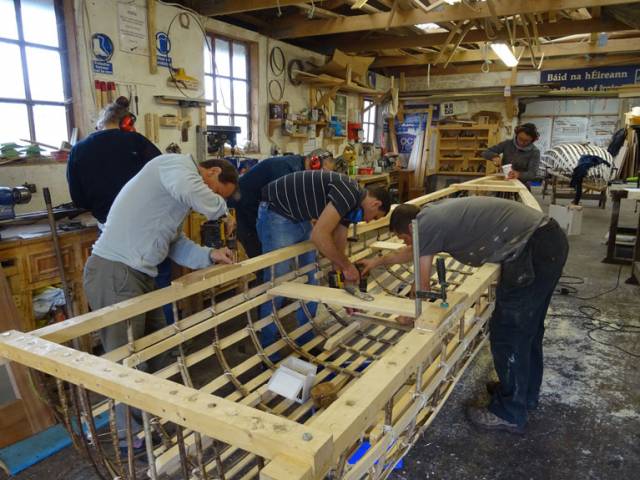In July of this year, a group of adults arrived in the boatyard at Meitheal Mara in Crosses Green in the heart of Cork City to learn about a proposed new boat-building programme. For 25 years now Meitheal Mara has been engaging with community groups all over Cork and working with disadvantaged and socially excluded individuals, providing them with boat-building and woodwork training. In a slightly new departure from this, in the summer of 2018, Meitheal Mara began a boat-building programme with a group of people living in direct provision.
The group of prospective boat-builders that arrived in Meitheal Mara’s workshop that day were a diverse bunch of people, coming from all over the world, and bringing with them a broad range of skills and experience. While some of them had prior experience of working with their hands, having previously worked in engineering and in construction, for others this was their first time doing anything of this nature. However, while they differed in their skill levels they all shared a similar interest in and passion for the work. Every week the workshop was filled with high motivation, great enthusiasm and fierce concentration to create a brilliantly finished vessel. Séamus O’Brien, Meitheal Mara’s workshop manager, described the group as ‘mad keen to learn’. He admits that at the beginning he wasn’t sure of how well the project would work. ‘Normally groups come to the workshop with their own project worker, someone to recruit and motivate the participants. In this case, we had to go to the accommodation centres ourselves to try to spread the word about the project.’ While this meant a good deal of additional work for the Meitheal Mara staff, Séamus is satisfied that all of this work paid off. ‘The project was a lovely experience. We all gained a lot from it.’
The boat-building course was part of a project entitled ‘Making a Connection through Currachs’, funded by the Heritage Council as part of the European Year of Cultural Heritage. Through their regular weekly participation, the group got to know every single step of the currach-build process, from cleaning and prepping the hazel rods to tarring the skin of the boat. The project also gave the group an awareness of a significant element of the cultural and maritime heritage of their new country of residence. It was clear to Séamus that this element of the currach-build intrigued the participants. ‘They were all very curious and really interested in our culture as well. They asked lots of questions about the currach all through the project’.
In fact, as part of Heritage Week in August, these novice boat-builders hosted members of the public at an Open Day in Meitheal Mara, demonstrating their newly acquired skills and knowledge to members of the public.
Now their boat a Dunfanaghy-style currach is completed and ready to be launched. On one of their last sessions in the workshop, the group sat down together to try to choose a name for their boat. There were lots of different suggestions in a lot of different languages but in the end, the boat-builders decided that an Irish name for their traditional Irish boat was most fitting and so ‘Bád Chorcaí’ (Cork Boat) was selected.
Bád Chorcaí will be launched at Lapps Quay pontoon at 4 pm on Tuesday 16th October. The boat will be joined on the water by Meitheal Mara’s fleet of Dunfanaghy currachs so that the boat-builders, their families and all of their supporters will have a chance to experience currach rowing.


























































